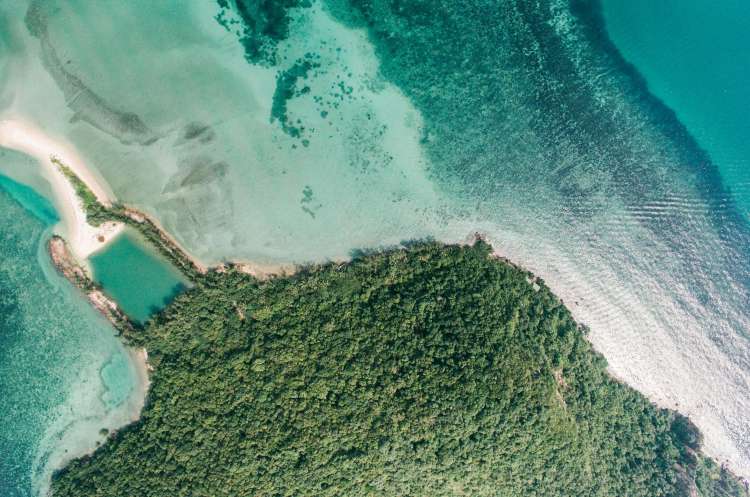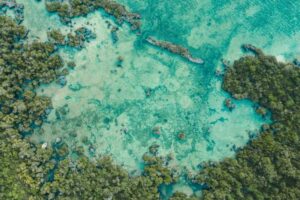
India’s ambition to become a $5 trillion economy has understandably focused on infrastructure, industrial growth, and technology. But the country’s vast 7,500-kilometre coastline—stretching across nine states and two island territories—remains a critically underutilised strategic asset. Coastal ecosystems, particularly mangroves and coral reefs, are not just natural wonders. They are frontline defenders against climate change, livelihoods for millions, and engines of economic growth.
While the government has launched initiatives to harness the blue economy, much more is needed to align marine conservation with national development. There is a need to re-examine the economic, ecological, and strategic significance of mangroves and coral reefs to generate a forward-looking agenda to turn these fragile ecosystems into pillars of sustainable prosperity.
READ I India’s carbon credit market must serve farmers, not just corporations
Mangroves: Guardians of the coast
India’s mangrove cover—spread over approximately 4.99 lakh hectares—constitutes nearly 3% of global mangroves. Prominent regions include the Sundarbans in West Bengal, the Andaman and Nicobar Islands, Odisha’s Bhitarkanika delta, and Gujarat’s coastal belts.
Mangroves shield coastal areas from extreme weather events. During the 1999 Odisha super cyclone and the 2004 tsunami, mangrove-rich zones suffered far less devastation. Their intricate root systems trap sediment, reduce tidal energy, and check erosion. They are also significant carbon sinks, sequestering carbon up to five times more efficiently than tropical rainforests.
Moreover, mangroves support rich biodiversity. They serve as breeding grounds for commercially important fish and crustaceans, underpinning nearly half of India’s coastal fisheries. Ecotourism—such as boat tours and wildlife excursions—offers supplemental income to many coastal households.
Coral reefs: Economic and ecological powerhouses
Coral reefs in India are primarily found along the Lakshadweep and Andaman & Nicobar islands, the Gulf of Mannar, and parts of the western and eastern coasts. Despite covering less than 1% of the ocean floor, these reefs support more than 25% of marine biodiversity. They provide natural barriers against wave surges, sustain reef-associated fisheries, and form the backbone of marine tourism.
In recent years, coral ecosystems have emerged as a frontier for marine biotechnology. Species inhabiting these reefs hold promise for pharmaceutical breakthroughs, including cancer therapies and novel antibiotics.
India’s coastal states and the blue economy
Each coastal state brings unique ecological and economic contributions. Gujarat and Maharashtra host mangrove belts and coral patches near major port cities. Kerala’s backwaters and Karnataka’s estuaries sustain vibrant tourism and fishing sectors. Tamil Nadu and Andhra Pradesh are home to coral habitats in the Gulf of Mannar and Palk Bay. Odisha and West Bengal’s mangroves form the core of the Sundarbans—Asia’s largest delta. The island territories of Lakshadweep and Andaman & Nicobar boast pristine reef systems critical to India’s biodiversity.
The Indian Ocean, bordering all these regions, represents one of the world’s most productive marine ecosystems. This maritime geography offers India a competitive edge in shaping a sustainable blue economy.
Government initiatives
Recognising the vital role of coastal ecosystems, the government has undertaken multiple conservation initiatives.
The flagship MISHTI (Mangrove Initiative for Shoreline Habitats and Tangible Incomes) scheme, announced in the 2023 Union Budget, aims to restore mangrove forests while creating sustainable livelihood opportunities. Gujarat, for instance, has successfully revived nearly 19,000 hectares of mangroves under MISHTI, reporting increased fish stocks and improved incomes for fisherfolk.
The National Coastal Mission, with an outlay of Rs 17.96 crore, focuses on restoring 38 mangrove and four coral reef sites through state–centre coordination. In Tamil Nadu, the Gulf of Mannar Biosphere Reserve is undertaking coral transplantation and seagrass restoration to regenerate marine habitats and boost tourism.
Karnataka’s upcoming marine sanctuary near Karwar—spanning 6,000 hectares—is a noteworthy step in protecting marine biodiversity while promoting eco-tourism.
Mounting environmental stress
Despite these efforts, India’s marine ecosystems are under mounting pressure. According to studies cited by the ministry of earth sciences, rising sea levels, industrial waste, and overfishing have severely degraded marine life. Fish stocks in Tamil Nadu and Kerala have declined by up to 75% over a decade, while plastic and chemical waste are choking the Odisha and Chennai coasts.
The Lakshadweep and Andaman reefs are bleaching at alarming rates due to warming seas. If these trends persist, India risks not only ecological collapse but also the loss of nutrition security and cultural heritage tied to the sea.

Emerging research from the US Geological Survey highlights an underexplored opportunity: mangroves may act as climate sanctuaries for coral species. Studies in the Caribbean show that corals growing within mangrove shade exhibit greater resilience to heat-induced bleaching.
India could tap into this strategy by protecting mangrove habitats near reef zones and exploring coral-mangrove hybrid conservation models—especially in climate-vulnerable regions like the Gulf of Mannar and Lakshadweep.
Coral farming: Innovation in the Indian Ocean
India has the opportunity to go beyond conservation through coral aquaculture or coral farming. This involves growing corals in controlled settings before transplanting them onto degraded reefs. Coral farms not only support reef restoration but also open up employment avenues in nursery management, marine tourism, and biotechnology.
To scale this effort, the government must identify suitable coastal sites, create coral aquaculture parks, incentivise private investment, and train local communities in coral nursery operations. These farms can become both ecological assets and tourist attractions.
Blue economy, fisheries, and eco-tourism
The economic value of healthy coastal ecosystems is immense. India’s seafood exports in 2023–24 stood at 17.81 lakh metric tonne, worth Rs 60,523 crore. Coastal tourism contributes significantly to state revenues and employment. Carbon sequestration by mangroves presents a clear opportunity to tap into international blue carbon credit markets.
If mangrove preservation and coral regeneration are mainstreamed into climate action plans, India can reduce infrastructure damage from storms, secure food sources, and lower disaster recovery costs—achieving adaptation while unlocking revenue streams.
Policy recommendations
India must now consolidate and scale its initiatives with clear institutional backing. Key actions include:
- Developing a National Marine Monitoring Network using satellite, drone, and AI-based technologies to track ecosystem health.
- Expanding blue carbon credit mechanisms, allowing communities to benefit from climate mitigation through mangrove conservation.
- Strengthening CRZ enforcement with stricter penalties and decentralised coastal policing.
- Scaling coral aquaculture parks, backed by PPP models and marine R&D.
- Boosting marine research funding to identify climate-resilient mangrove and coral species.
- Empowering communities through training, financial support, and participatory resource management.
- Integrating marine conservation into school curricula to foster long-term ecological stewardship.
India’s coastal states are more than geographic entities—they are lifelines to a sustainable future. Mangroves and coral reefs form the foundation of this promise. While initiatives like MISHTI and the National Coastal Mission are important, they must be matched by a broader ecosystem of innovation, investment, and inclusion.
The Indian Ocean is India’s greatest geopolitical and ecological frontier. If managed wisely, it could propel India’s rise not just as an economic power, but as a global leader in marine sustainability.
Mangrove forests and coral reefs must no longer be seen as passive victims of development, but as essential economic infrastructure. Their conservation is not a luxury—it is a necessity for growth that is climate-resilient, inclusive, and enduring.
Sumaya Jan is a Research Scholar at the Department of Economics, Central University of Jammu. Sameer Hussain Gull is a Research Scholar at the Department of Management Studies at Central University of Kashmir.
